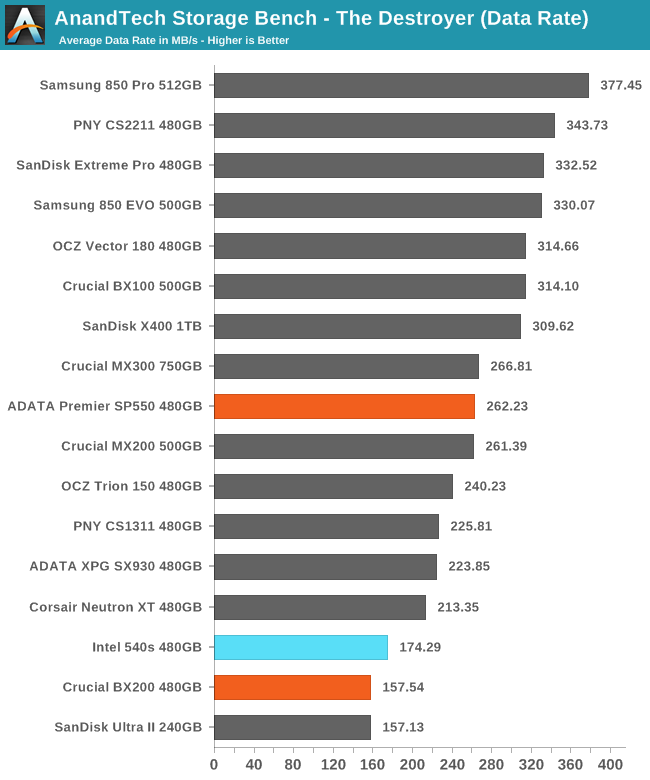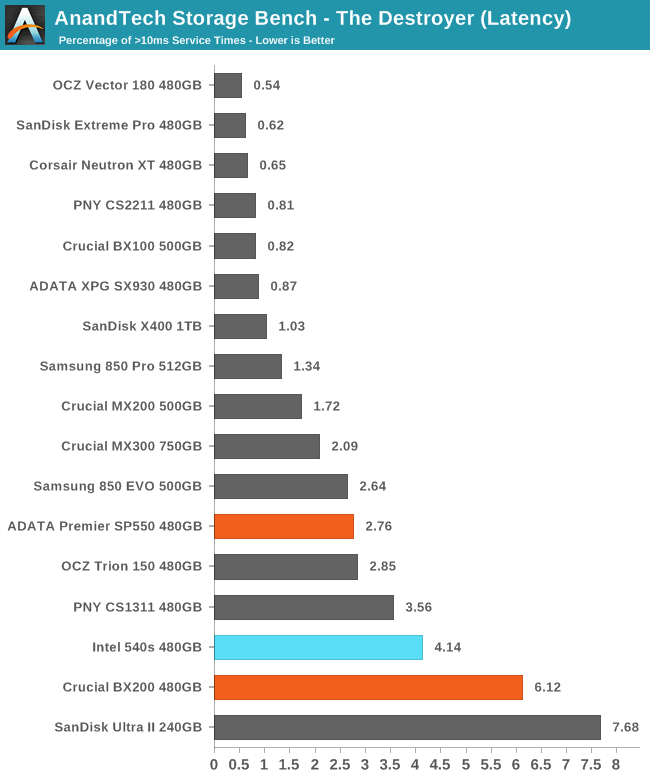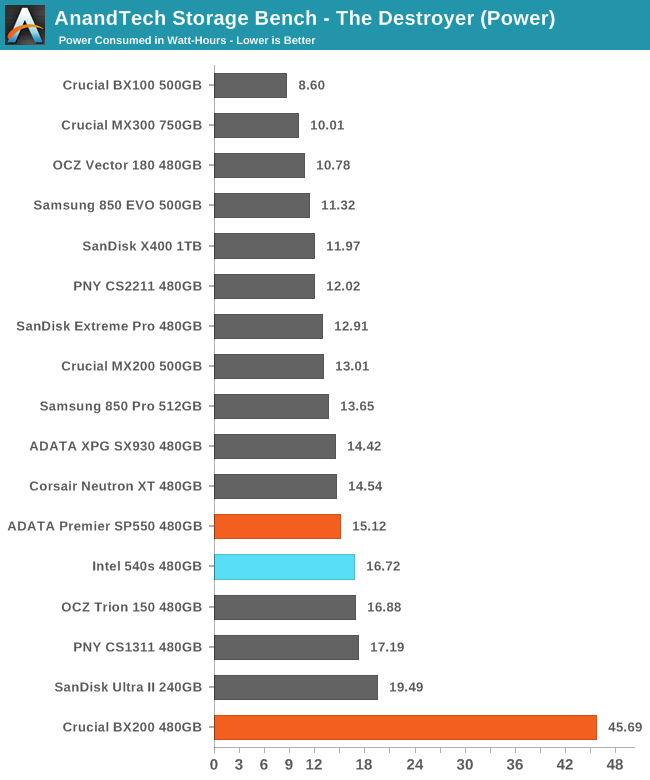The Intel SSD 540s (480GB) Review
by Billy Tallis on June 23, 2016 9:00 AM ESTAnandTech Storage Bench - The Destroyer
The Destroyer is an extremely long test replicating the access patterns of very IO-intensive desktop usage. A detailed breakdown can be found in this article. Like real-world usage and unlike our Iometer tests, the drives do get the occasional break that allows for some background garbage collection and flushing caches, but those idle times are limited to 25ms so that it doesn't take all week to run the test.
We quantify performance on this test by reporting the drive's average data throughput, a few data points about its latency, and the total energy used by the drive over the course of the test.

On The Destroyer, the ADATA SP550 was able to punch above its weight and perform on par with planar TLC drives of twice the capacity, while the Crucial BX200 performed below expectations. The Intel 540s unfortunately demonstrates more of the latter, with an average data rate that is not as bad as the BX200 but is still clearly outclassed by the Phison S10 TLC drives and the SP550.

As with the average data rate, the average service time of the 540s is poor but not quite as bad as the BX200. The SP550 didn't rank much higher on this metric, but in absolute terms it was significantly faster.


The frequency of latency outliers shows similar rankings, with the Intel 540s near the bottom of the chart and between the two SM2256 drives.

Power efficiency has regressed slightly compared to the SP550, but the Intel 540s clearly doesn't have anything horribly wrong going on the way the BX200 did.










77 Comments
View All Comments
Notmyusualid - Thursday, June 23, 2016 - link
Ya saved me from writing it...shelbystripes - Thursday, June 23, 2016 - link
Intel is considered a reliable brand to OEM PC makers and other bulk purchasers. Offering a low-end part means capturing business that might go to a second-tier manufacturer. For builders with a use case where any modern SSD is fast enough, and you care about reliability without breaking the bank, this will be the #1 choice. You get the Intel name and the things INCLUDED with that, like solid customer support and timely firmware updates, at a lower price point.Nobody buying this is expecting it to be a performance part. Intel is the company that sold Celerons with no L2 cache, that sells cut-down Atom CPUs and Core CPUs under the same Pentium brand name. Intel doesn't always mean performance. It does mean confidence that what you're buying actually works, though.
BurntMyBacon - Friday, June 24, 2016 - link
@shelbystripes: "Offering a low-end part means capturing business that might go to a second-tier manufacturer. For builders with a use case where any modern SSD is fast enough, and you care about reliability without breaking the bank, this will be the #1 choice."You know, Intel used to cater to this market, ... , with their 300 series drives. Interestingly, the relative performance of this drive matches up to where their 300 series used to slot in as well. Why is this not a 300 series drive?
vladx - Friday, June 24, 2016 - link
My tablet running an Atom quad-core works great. To compare this joke of a SSD from Intel to that is a fucking joke.plopke - Thursday, June 23, 2016 - link
Won't the 540 be shortlived? Shouldn't we be seeing 3d nand drives of intel soon followed by optane?https://i0.wp.com/benchlife.info/wp-content/upload...
A5 - Thursday, June 23, 2016 - link
This is for a different market segment.Billy Tallis - Thursday, June 23, 2016 - link
That roadmap shows the 540s sticking around at least through Q1 2017, and merely being joined by some Optane and 3D TLC NVMe drives. The actual replacement of the 540s is at an indefinite point in the future.The determining factor will be how long it takes 3D NAND to get cheap enough to displace 15/16nm TLC. I don't think that will be happening any time soon; even Samsung apparently can't pull it off yet, since they introduced the 750 EVO.
Mobile-Dom - Thursday, June 23, 2016 - link
IIRC Samsung used planar NAND in the 750 because they wanted lower capacity without the performance degradation, as by using the high layered 3D NAND they used fewer packages resulting in worse performance for drives that had 1 or 2 packages for the entire SSDextide - Thursday, June 23, 2016 - link
Nah, both their planar 15/16nm and their 3D NAND use 128Gb dies -- so same amount of dies in either product. It's purely a cost thing. It will probably take until we get into the 100+ layers of 3D NAND for it to be competitive, cost wise, with that 15/16nm planar TLC.Billy Tallis - Thursday, June 23, 2016 - link
That's what they said at first, but then they introduced a 500GB 750 EVO while the 850 EVOs on the market are still using the 32-layer VNAND.